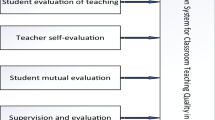Abstract
There are some problems in the quality evaluation of network distance education, such as the large error in the quantitative results of the evaluation indicators, the low accuracy of the quality evaluation and the large error in the indicator's weight distribution. Therefore, a quantitative evaluation method of NDE reliability based on Back Propagation (BP) neural networks and fuzzy comprehensive evaluation is proposed. From the perspective of students, teachers and schools, the primary and secondary indicators of teaching evaluation are constructed, and the reliability evaluation indicators system of teaching quality is established. The fuzzy comprehensive evaluation method is used to calculate the membership degree of the evaluation indicators, the consistency verification method is used to determine the consistency of the indicator's attributes, and the quantitative research of the indicators data is completed by the weight calculation method to improve the accuracy of the quantitative results. BP neural network is used to construct the input layer, hidden layer and output layer of network distance education quality reliability evaluation indicators, calculate the weight of evaluation indicators, transform the input evaluation indicators data through linear conversion function, construct the indicators evaluation model, and correct the evaluation results with the help of loss function to improve the accuracy of quality evaluation results. The experimental results show that the evaluation result error of the proposed method is relatively small, with an error of less than 0.3%, and the highest evaluation accuracy reaches 96.3%, which can effectively improve the quantitative evaluation effect of the reliability of network remote teaching quality.









Similar content being viewed by others
Data availability
Not applicable.
References
Liu P, Wang X, Teng F (2021) Online teaching quality evaluation based on multi-granularity probabilistic linguistic term sets[J]. J Intell Fuzzy Syst: Appl Eng Technol 40(5):9915–9935
Li Y, Zhu J, Fu W (2022) Intelligent privacy protection of end user in long distance education[J]. Mob Netw Appl 27(3):1162–1173
Hou J (2021) Online teaching quality evaluation model based on support vector machine and decision tree[J]. J Intell Fuzzy Syst: Appl Eng Technol 40(2):2193–2203
Hou C, Hua L, Lin Y, Zhang J, Liu G, Xiao Y (2021) Application and exploration of artificial intelligence and edge computing in long-distance education on mobile network[J]. Mobile Netw Appl 26(5):2164–2175
Bao L, Yu P (2021) Evaluation method of online and offline hybrid teaching quality of physical education based on mobile edge computing[J]. Mobile Netw Appl 26(5):2188–2198
Lin Q, Zhu Y, Zhang S, Shi P, Guo Q, Niu Z (2019) Lexical based automated teaching evaluation via students’ short reviews[J]. Comput Appl Eng Educ 27(1):194–205
Zheng J (2020) Analysis of online teaching mode and effect of computer network under large-scale users[J]. Int J Emerg Technol Learn 15(20):182–193
Lu C, He B, Zhang R (2021) Evaluation of english interpretation teaching quality based on GA optimized RBF neural network[J]. J Intell Fuzzy Syst: Appl Eng Technol 40(2):3185–3192
Sun Q (2021) Evaluation model of classroom teaching quality based on improved RVM algorithm and knowledge recommendation[J]. J Intell Fuzzy Syst: Appl Eng Technol 40(2):2457–2467
Mohandes SR, Zhang X (2019) Towards the development of a comprehensive hybrid fuzzy-based occupational risk assessment model for construction workers[J]. Saf Sci 115(6):294–309
Sivaraman G, Vishnukumar P, Raj M (2020) MCDM based on new membership and non-membership accuracy functions on trapezoidal-valued intuitionistic fuzzy numbers[J]. Soft Comput 24(6):4283–4293
Zhang L, Liang F (2021) Monitoring and analysis of athletes’ local body movement status based on BP neural network[J]. J Intell Fuzzy Syst 40(2):2325–2335
Hu J, Zhao W, Tang J, Luo Q (2021) Integrating a softened multi-interval loss function into neural networks for wind power prediction[J]. Appl Soft Comput 113(12):108009
Azimaee P, Jozani MJ, Maddahi Y (2021) Calibration of surgical tools using multilevel modeling with LINEX loss function: Theory and experiment:[J]. Stat Methods Med Res 30(6):1523–1537
Jahantigh FF, Ostovare M (2020) Methods and instruments application of a hybrid method for performance evaluation of teaching hospitals in Tehran[J]. Qual Manag Health Care 29(4):210–217
Acknowledgements
This work was funded by Researchers Supporting Project number (RSPD2023R636), King Saud University, Riyadh, Saudi Arabia.
Author information
Authors and Affiliations
Corresponding author
Ethics declarations
The authors have no relevant financial or non-financial interests to disclose. Xiao Liu provided the algorithm and experimental results and wrote the manuscript, Gautam Srivastava discussed the direction, supervised and analyzed the experiment, and Maazen Alsabaan provided the experiment environment and revised the manuscript. We also declare that data availability and ethics approval does not apply to this paper.
Additional information
Publisher's Note
Springer Nature remains neutral with regard to jurisdictional claims in published maps and institutional affiliations.
Rights and permissions
Springer Nature or its licensor (e.g. a society or other partner) holds exclusive rights to this article under a publishing agreement with the author(s) or other rightsholder(s); author self-archiving of the accepted manuscript version of this article is solely governed by the terms of such publishing agreement and applicable law.
About this article
Cite this article
Liu, X., Srivastava, G. & Alsabaan, M. Quantitative Evaluation of NDE Reliability Based on Back Propagation Neural Network and Fuzzy Comprehensive Evaluation. Mobile Netw Appl 28, 914–923 (2023). https://doi.org/10.1007/s11036-023-02188-6
Accepted:
Published:
Issue Date:
DOI: https://doi.org/10.1007/s11036-023-02188-6




